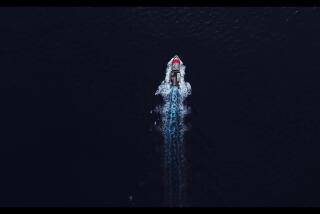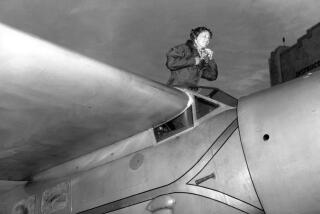Amelia Earhart mystery: New evidence, right spot, searchers say
In July, a team searching for the wreckage of Amelia Earhart’s plane was wrapping up an expedition and feeling downhearted. They had come away with apparently little to show for their $2.2 million worth of efforts.
But now those searchers says high-definition video from that trip shows promising evidence.
“We have man-made objects in a debris field,” Ric Gillespie told the Los Angeles Times in an interview Monday morning. And those objects are “in a location where we had previously reasoned where airplane wreckage should be.”
Earhart and navigator Fred Noonan were lost on their July 2, 1937, flight from New Guinea to Howland Island in the central Pacific Ocean. Earhart was trying to become the first woman to fly around the planet.
“We don’t want to oversell this,” Gillespie cautioned. “We have lots of clues. ... It looks like it might be the right stuff, but we need a lot more work done, and ultimately we’re going to have to go back and recover it.”
Gillespie is the executive director of the International Group for Historic Aircraft Recovery. TIGHAR has an exclusive agreement with the island nation of Kiribati to search for and recover any artifacts from the plane wreck -- which Gillespie and his wife and search partner, Pat Thrasher, are sure occurred there.
The debris field that was captured in the underwater high-definition footage jibes with the location shown in a blurry 1937 photo that is said to show a plane’s landing gear, Gillespie said.
The team made its most recent journey to the remote location in July. Technical difficulties marred the trip, Gillespie said. Twice they had to rescue their searcher -- a torpedo-shaped autonomous underwater vehicle.
“You program it, put it over the side, it collects its sonar data and comes back,” Gillespie said. “But it didn’t always come back. On two occasions, it got stuck underwater. Then we had to go and rescue it” with another piece of equipment.
Due to technical problems, their planned 10-day trip was trimmed back, with only five spent searching the waters. Although the team collected high-definition video, he said, what they saw as they were searching was in standard definition.
“We were not seeing anything of interest and were pretty bummed,” Gillespie said. Among those on board was a donor, Tim Mellon. The railroad magnate had donated $1 million to the voyage and accompanied the crew.
Also providing backing, according to Gillespie: Lockheed Martin and the Discovery Channel -- which bought the rights to make a documentary about the expedition (it aired Sunday). Then there was FedEx, which moved 30,000 pounds of various cargo over 17,000 miles -- for free.
The U.S. State Department had even encouraged the privately funded voyage.
Pressure? Yes, and Gillespie was feeling it. And then came the technical problems and shortened search.
When the July expedition ended, TIGHAR said in a statement that it had seen no objects recognized as aircraft debris, “but we have volumes of sonar data and many hours of high-definition video to review before we’ll know the results of this expedition definitively.”
After returning home, that video went to a forensic imaging specialist, Gillespie said, who pored through 5 1/2 hours of footage and highlighted two spots, saying, “We have man-made stuff here.”
Using the time code from the footage, Gillespie pinpointed the location of the man-made objects, which coincided with sites where the team had expected to find the debris of a plane -- “off the edge of the reef seen in the 1937 photo.”
Gillespie’s hope is to raise more money and return to recover what was found. He’d like to make use of two submersibles, each with three-person crews.
“You start putting people down there,” he said, “and it’s a whole different ballgame.”
Another expedition would mean raising as much as $1 million. So the next search will be for funding.
Eventually, Gillespie’s dream is to recover “whatever remains of the aircraft,” providing evidence that earlier objects found on the island belonged to Earhart and Noonan. Those objects, he said, show “their attempts to boil water ... to make a spear, the evidence of a castaway trying to survive.”
All those relics he’d eventually like to see in a traveling museum exhibit, with some of its profits going to Kirabati. The island nation is desperately poor, he said, and literally losing ground as climate change causes sea levels to rise.
After that, he’d like to see those artifacts at the Smithsonian Institution-- “exhibited right there next to Amelia Earhart’s Lockheed Vega. This is the final chapter in her life and it needs to be discovered and documented and shared.”
ALSO:
Plane crashes into Long Island neighborhood
Pipeline opponents lack national platform of Keystone XL
Could John Lennon’s killer be paroled at his seventh hearing?
More to Read
Sign up for Essential California
The most important California stories and recommendations in your inbox every morning.
You may occasionally receive promotional content from the Los Angeles Times.











